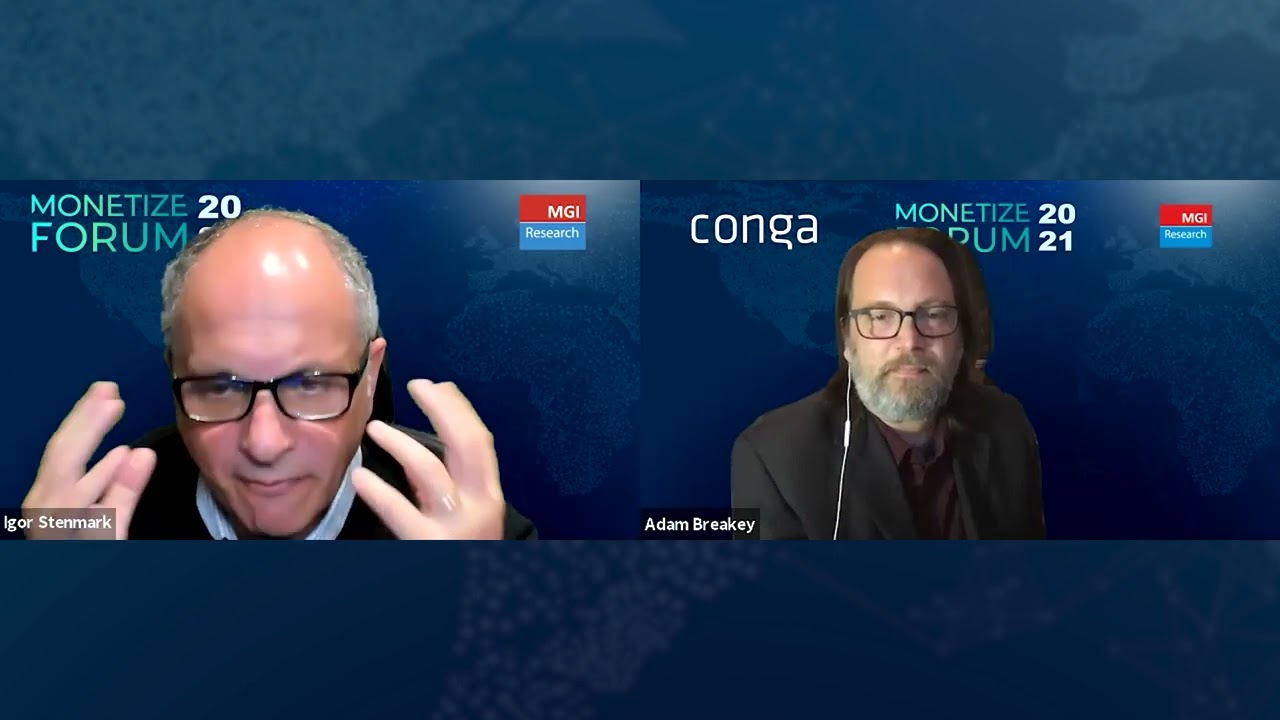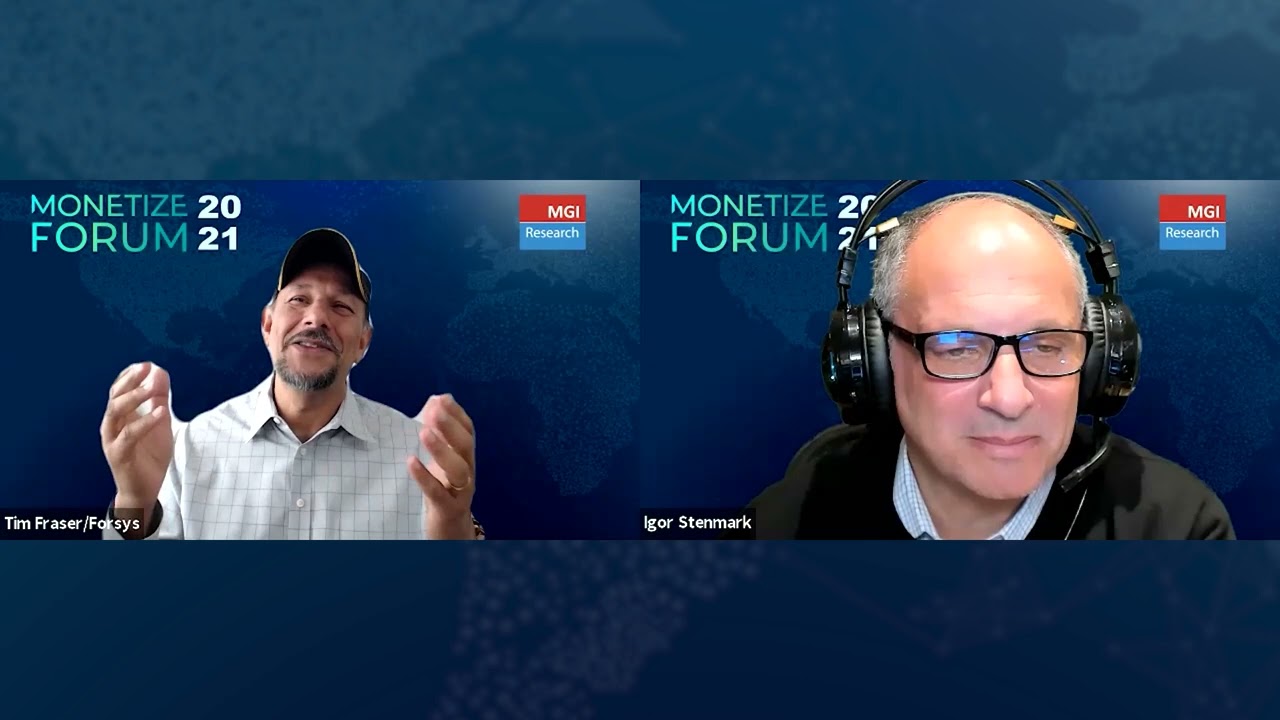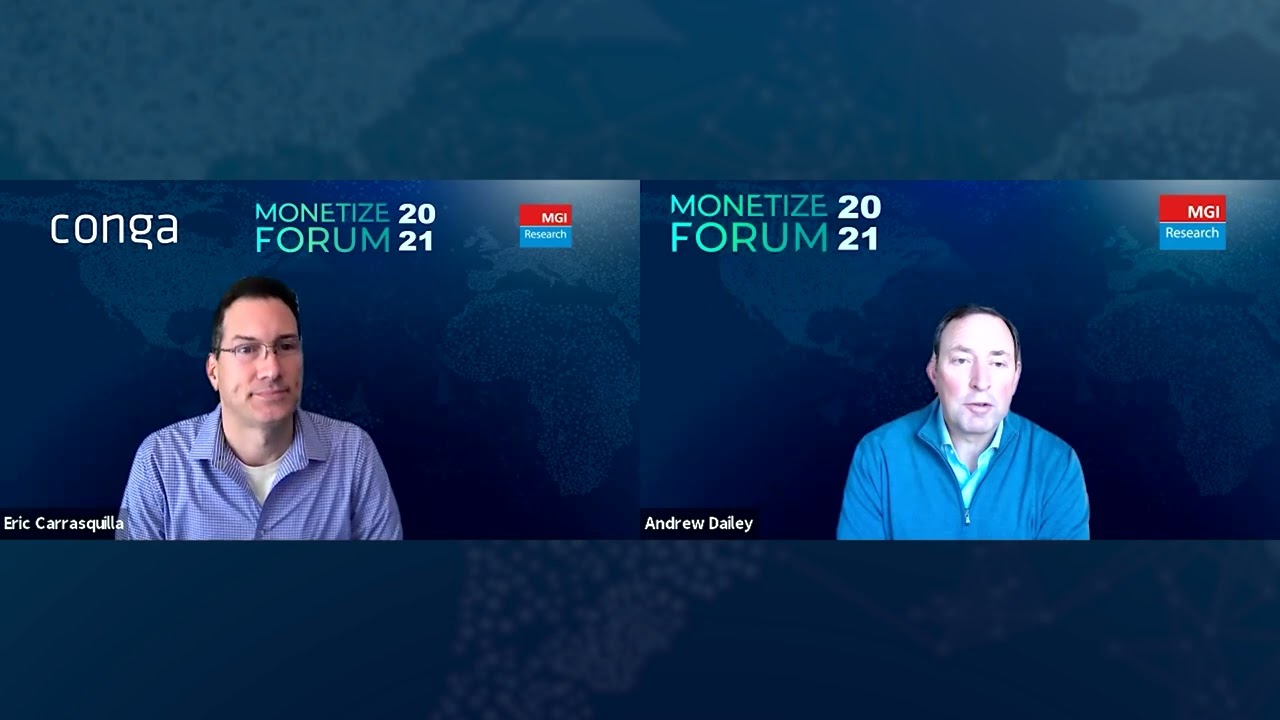Consumption-based models can be complicated even at moderate scale. For large, established enterprises, making the switch from offering “buy-and-own” to “subscribe-and-use” solutions adds further layers to an already massively complex operation. Adaptation to changing customer demand and behavior is a must, though, even for companies with the strongest reputations. To get a sense of the tools and strategies that can help facilitate a successful transition to a usage-based system, we invited SAP SE IT Manager Benno Matschinsky to speak at this year’s Monetize Forum. In his conversation with MGI Research analyst Igor Stenmark, Benno offers advice from the other side for companies considering embarking on a business model transition.
Key Issues
How are established enterprises adapting to trends in the market?
What are the dimensions of complexity that need to be considered in adopting a consumption-based model?
What steps can companies take to simplify a transition to usage?
Guest Profile
Benno has spent most of his over 30-year technology career at SAP, with assignments covering software engineering, contract management, and running of the internal ERP system.
His current focus is on running the core internal monetization systems behind SAP products such as Concur, Ariba, and SAP Cloud, among others.
Igor Stenmark
Hello, this is Igor Stenmark of MGI Research at the 2021 Monetize Forum conference. In our next session, “Streamlining Global Quote to Cash,” we’ll hear from one of the senior enterprise technology professionals at SAP with responsibility for key parts of global quote-to-cash operation. Typically, we hear from SAP as a vendor, but our guest speaker today, Benno Matschinsky, comes from within SAP’s internal IT organization, an organization that supports monetization of its key software products. Benno plans to share with us some lessons learned from SAP’s own experience in scaling up complex consumption-based pricing models.
Benno has spent most of his over 30-year technology career at SAP with assignments ranging from software engineering to contract management to running internal ERP systems. His current focus is running the core internal monetization systems behind SAP products such as Concur, Ariba, and SAP Cloud, among others. He’s joining us today from Walldorf, Germany. Benno, welcome to Monetize Forum 2021. Thank you for your participation—we’re delighted to have you as a guest.
Benno Matschinksy
Thank you for inviting me.
Igor Stenmark
I normally start by asking guests to introduce their companies, but in this case, it would be pretty silly because basically everybody knows who SAP is and what you do. You guys are the leading provider of software for business applications, and I think it’s likely that many members today are already SAP customers. Instead, I’d like to ask you to give us a more in-depth picture of the kinds of things that you’re focused on at SAP.
Benno Matschinksy
Yes. I’d like to talk to you not necessarily about the SAP products but the fact that we’re trying to adapt (and have been adapting) the solutions that support our businesses and consumers in a change of behavior over the last couple of years. Businesses are looking for predictable revenue and cashflow, and the customers are looking more for the dependable services that SAP offers and, of course, the predictable cost along with that. What does that mean for us?
Our focus is that, in this adaption, we’re going from a buy-and-own type of solution support to more of a subscribe-and-use solution support, without leaving the other ones behind. At the same time, that has to support a plethora of products and services from SAP: SAP Cloud Platform (one of the first ones that we tried to move onto this monetization platform) C/4 and S/4, the networks like Ariba Supplier, our professional services, and other acquisitions like Qualtrics in experience data services and solutions that we offer.
What we’ve seen on our IT solution side is that the solution has to cater more towards an adjusted cycle time—cycling time from a yearly to a monthly invoice, for example. That means many more invoices. As an example of the kinds of numbers we’re seeing, previously, an O2I operational expert in our finance department would cover maybe 10,000 invoices per year. Even if we’re expanding, our staff members now still have to cater to about 150,000 invoices per year. That gives you an idea of some of the pressures or behavioral changes that we have to adapt towards.
Igor Stenmark
What are some of the average dimensions aside from just volume? You guys operate at tremendous scale with customers all around the world. What are the other dimensions of complexity here? Volume is one, obviously, but operating kind of on-demand and consumption-based is a new experience for most companies, even for you guys. Were you ready for this?
Benno Matschinksy
To some degree, yes. The complexity we already had because we have very complex relationships with customers on a certain customer journey, mashed with sometimes complex sales journeys due to a number of acquisitions in the past with different variants that we have to sort of collect. That’s, of course, along with an operational journey or complexity that we also have to bring in. At the same time, we try to cater to the changing behavior and volume, and because those customer relationships are complex, that means we have a complex master data structure involving hierarchy, et cetera. There are also all the different operational setups from all the different products that we had. We tried to converge, but we still have variants there. We have different customer data behaviors and user metrics that we’re collecting, and we try to feed that into a solution that can then charge against those complex models that we still have. We assume that it will take time to converge to a simplified sales model or a simplified data model of understanding our customers’ behavior and then charging against that.
Igor Stenmark
So, there’s a variety of different kinds of vectors here. You have complex product genetics, complex contractual relationships, huge volumes, and, I imagine, also huge issues or regulatory considerations—what gets charged, what doesn’t get charged, how, where, in what currency and language, and so on.
Benno Matschinksy
Exactly. So, we do have the complexity also of all the countries of the world, all the different languages, and the compliancy when we’re talking about the invoice itself. For example, in the CIS region, compliance will be different than in the United States, for sure. SAP is very, very strong in trying to comply as much as possible, of course.
Igor Stenmark
Yes. What’s your sense of where SAP is now in terms of its adoption of a usage-based pricing model or, going beyond even, an outcome-based pricing model? You guys have been doing subscriptions for a very long time, but usage-based and consumption-based are still relatively new as I understand it. This would be on a big scale and not on a kind of experimental scale. I’m talking about a broad adoption level. Where do you think SAP is in terms of its maturity in dealing with something like that, and what are some of your key strategies in this area?
Benno Matschinksy
We actually had products and customers using subscription and pay-per-use already in place, so we were able to leverage some of our experience in helping those customers going in. We’ve been able to draw on that through product as well. I think we’re at a stage now where we can easily have subscription integrated with the CPQ solution on down into revenue and accounting—so with the accounting principles applied to this as well.
The subscription is very solid and works very well for us. We have a very strong maturity level there. We have a rather solid solution supporting consumption, usage, or pay-per-use in, say, a cloud platform product space, anything that builds on a cloud platform, as well. So, I think we’re starting at a very good stage where we can begin to experiment with some other ideas that our businesses and sales responsibles come up with over time to add on top. This doesn’t mean that we have covered all of the product base, but we’re at a level where we can start to add and venture even further.
Igor Stenmark
Right. For companies that are thinking about going in the same direction as you have in terms of enabling the consumption-based business model as a more or less standard model on your internal platform, what have you learned from your experience, and what advice would you offer them?
Benno Matschinksy
Well, in essence, we could have or should have simplified a bit more than we have so far.
Igor Stenmark
So, remove complexity, I guess.
Benno Matschinksy
Yes, we have to simplify the complexity. Additionally, we have to standardize. We’ve done some standardization, of course, especially when it comes to that metering as a service with our cloud services that we offer, for example. We did that standardization, simplification, and unification, and we’ve had an easier time with it.
Continuing on that theme, we’re trying then to also unify and simplify our invoicing and get basically all of invoicing onto a unified platform. We’re trying to bring all our cash collection onto a unified platform and work forward in that pattern. The other step is that we have to digitize basically everything in order to allow for reconciliation. Don’t depend on a person to do that because of the volume. Automate every step of the way—checks and balances, et cetera.
And, of course, we do need to and have been trying to leverage some of the newer ideas in the sense of machine learning or learning solutions which SAP has so that we can, say, predict if a charge is actually accurate or not and think towards working with exceptions or clarification cases rather than checks and balances from a person as a rule. To summarize, it’s basically simplify, standardize, digitize, and automate. Focus on that.
Igor Stenmark
What does your technology stack look like? Is it all kind of homegrown, internal SAP off-the-shelf products, or is it a mix of internal and third parties? I’m particularly interested in the data aspect of what you’re doing because we’ve seen companies that are way smaller than you guys that try to do what you’re doing, and they drown in data (especially in dirty data) when they try to unify and simplify the situation. What does your stack look like? What kind combination do you use? What is the footprint that you operate off of today?
Benno Matschinksy
In essence, we’re kind of lucky, or at least I think we’re kind of lucky. We have an SAP-standard suite of platforms and applications that we can start from. We try to do “SAP runs SAP.” SAP runs SAP doesn’t mean all of the components in that suite—the BRIM suite on S/4HANA as an example that we’re talking about here—are from SAP itself. We’ll of course partner with other companies. DigitalRoute fits very nicely with their mediation zone to help us in bringing the metered data into our commercial platform itself, distributing, and doing other data services there that are involved with that. Of course, there’s the BRIM itself, plus we use our own revenue accounting solution with which we would integrate because we do have an invoice-based revenue model and other products such as OpenText for digitizing the invoice and distributing it in a digital form. We use Adobe products to help us with the online presence when we actually, for example, have an online version of the invoice itself as well.
Igor Stenmark
Right. We talked briefly before about the kind of complexity dimensions of what you’re doing. You also have a lot of partners that you work with in the cloud area as well as a lot of other third-party software vendors, whether their bringing you business or you’re bringing them business. With that complex system there, how do you manage all the data that’s floating around?
Benno Matschinksy
A really prime example of the complex relationships that we have to cater and adapt the solution to in the space of consumption data is our relationship with hyperscalers and Microsoft—hyperscalers selling our products to end customers along with their own products. In these situations, we have to be able to deliver the usage of those services that they’ve sold to that end customer on to Microsoft or another hyperscaler, so they can then in turn charge their end customer. That means that we also have to add in additional features to solve for charging an aggregate across the multiple customers that they have and, of course, charging them at a discount. They need to make some money, right? Other relationships involve supporting some of those partners that I mentioned on the monetization platform that we have, like DigitalRoute, OpenText, or others that we also use through our “SAP runs SAP” offerings.
Igor Stenmark
Right. In terms of running monetization at the scale of SAP and, specifically, thinking about consumption-based and usage-based pricing models, you mentioned some of the key do’s and don’ts. For companies that are thinking of going in this direction who haven’t made it there but are maybe experimenting right now, what should be their priority? You mentioned simplification, some aspects of data management, mediation, and so on. What should they be focusing on first in going this direction?
Benno Matschinksy
I’d like to say that actually, you’ll never be completely ready. So, start simple, try early, and mature it over time. We couldn’t just put everything on a subscription and consumption-based model because we didn’t have everything already on subscription and consumption. So, you have to assume that you’ll be running in parallel, but you have to start small and simple, then mature it over time. Maybe start with subscription first, then add the pay-for-use on top. I would think that you should be ready for data quality issues with a large impact, especially when you go to the consumption-based billing space, because as soon as you get a charge wrong, you’re probably going to get it wrong for a lot of customers at once.
Igor Stenmark
Yes, it’s asymmetric; it multiplies up.
Benno Matschinksy
Right. So, you have to build for failure in that sense. Also, automate those checks, and get them in as early as possible. We try to actually bring the customer into the equation in the sense that we may start charging, say, during the course of the month, even though the invoice will come at the end of the month. And we give them transparency in their usage and transparency in the potential charge that might come towards the end of the month, just as another option.
We’ve started to look at testing our solutions a bit more beyond the acceptance criteria of what I expect from a business point of view or customer point of view, looking at behavioral patterns in the data and in production. We haven’t yet reached that level, but that’s something that we see as helping us because quite often it’s, “What’s the check that everybody does? Does it fit to my experience over the last months of that particular customer (because I’m checking based on the customer experience in my acceptance)?” Why can’t I build it in as an automation? We see that as helping us make sure that we have a reliable monetization platform for our business and, in essence, for the customer.
The last one is, don’t look too far back as far as cycles are concerned. We’re challenging that a bit, asking why we should look at the behavior from two years back in order to figure out what our charge potentially is today.
Igor Stenmark
Okay. We’re almost out of time in our session. We could probably keep going here and talk for another hour or so, but to conclude, I wanted to ask you one more question. What is one thing that people don’t know about SAP that they should?
Benno Matschinsky
Well, I think something that has carried me through and kept me here is that I know SAP is always trying with their heart to basically do the right thing. They try to make sure that we deliver the right thing for our customers and the people at SAP itself. We’re working with each other, and there’s a lot of heart involved.
Igor Stenmark
All right. Benno, thank you very much for joining us here, for your time, and for sharing some words of wisdom. I hope you have a good rest of Monetize Forum 2021. Thank you all for joining us.
Benno Matschinsky
Thank you.




